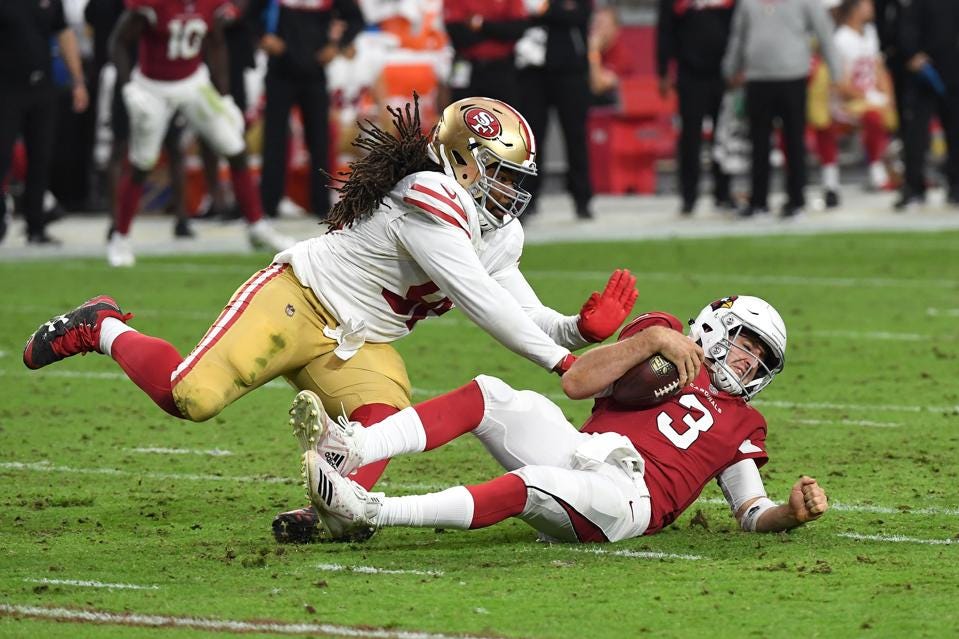Why You Should Coach Your Financial Advisors Like An NFL Roster
In the NFL, even the best players have to earn their spot every season — and the people managing your money should be held to the same standard.
I had the sincere privilege of talking to an active NFL pro this week, Sheldon Day, who, along with Richard Sherman started The Players Company to each other professional athletes and investors how to navigate the complexities of money management in a world where 78% of pro athletes suffer from financial distress post sport.
And one of the big problems he illuminated is that the level of trust that athletes put in agents and, uh, financial advisors is often misplaced. I couldn’t disagree with a word he said, and his counsel to athletes is, I believe, something that you can apply in your own life and financial plan as well.
In this week’s Net Worthwhile Weekly, you’ll get an article on Why You Should Coach Your Financial Advisors Like An NFL Roster, in addition to the podcast episode I recorded with Sheldon, along with an update from our resident investment guru, Tony Welch, on the many machinations in this Weekly Market Update, Fundamentals Driving the Magnificent Seven.
Thanks for joining us this and every weekend!
Tim
Tim Maurer, CFP®, RLP®
Chief Advisory Officer
In this Net Worthwhile® Weekly you'll find:
Financial LIFE Planning:
Why You Should Coach Your Financial Advisors Like An NFL Roster
NWWW Podcast:
Sheldon Day On Wealth, Legacy, And The Players Company
Quote O' The Week:
Simon Sinek
Weekly Market Update:
Fundamentals Driving the Magnificent Seven
Financial LIFE Planning
Why You Should Coach Your Financial Advisors Like An NFL Roster
In the NFL, even the best players have to earn their spot every season — and the people managing your money should be held to the same standard.
Sheldon Day’s NFL story began with a narrative that is similar to many, but he’s insistent that it does not end the way that many do, with 78% of professional athletes experiencing financial distress post-sport.
He grew up in a relatively poor community on the east side of Indianapolis and did all the work to become an All-American and two-time captain at a little-known football school called Notre Dame.
He experienced that moment of euphoria when he was drafted by the Jacksonville Jaguars, and figured all of his financial worries were over when he got a six-figure signing bonus. Only, he got his first financial shock when he learned that six figures quickly becomes five after taxes.
It was the first of many signs he received that the financial landscape is much more complex than it often appears—and that you can’t trust all the guidance that is thrust upon a young athlete when you don’t even know what questions to ask. So, in a stint with the San Francisco 49ers, he and teammates Richard Sherman and Tom Zheng banded together to form The Players Company, an organization designed to help “athletes and investors achieve their full financial potential,” through education, tools, and resources designed to help them “grow, manage, and sustain generational wealth.”
I asked Day in a recent podcast interview why this was so important. Because sadly, too many pro athletes have learned that they can’t fully trust the people who have historically given them guidance. Yes, there are plenty of great agents and financial advisors out there, but the above referenced statistic—and too many stories of self-interested representatives—suggest that the old adage, “Trust, but verify,” may need to be reversed.
And while the stakes may be higher for pro athletes making millions, the following guidance is applicable to you, too, and anyone looking to fill out the ranks of their personal advisory council:
Role Reversal—You’re The Coach Now
Sheldon Day and every other NFL player have been evaluated by coaches and owners their entire lives, but when building out his team of representatives, he’s assuming the coaching role. And you are similarly empowered to do the same.
I get it; the financial, estate, and tax worlds are horribly complex and rife with jargon, precedent, and tax code that feels like it requires you, as client, to assume a submissive posture. But the truth is that you are the CEO of this enterprise. The CEO likely isn’t, and doesn’t have to be, as knowledgeable about finances as the CFO, nor as conversant in legal matters as Chief Counsel. But everyone needs to know the chain of command.
Practically speaking, this certainly means that your trusted advisors should act accordingly, but it also means that you need to have the courage to say, “Give it to me in plain English,” when someone talks over your head, instead of nodding through and hoping for the best.
You Define The (High) Standards
“In sports, if you have a bad practice, you get cut,” Day told me. He applies the same principle to his financial life—the people in your inner circle should be consistently operating at their highest level. But how are those standards set?
In professional sports, the metrics are clear, but in your personal finances, you create them. Your advisors should absolutely have best practices and standard operating procedures, but you define what good looks like. And just like a good coach, you should set those expectations accordingly.
Many great advisors will ask these questions up front:
How many times per year would you like to meet?
Do you prefer to meet in person or virtually?
What are your communication preferences?
How would you define success in our working relationship?
You may have your own list of questions:
How are you compensated?
How do you navigate conflicts of interest?
When should I expect phone calls and emails to be returned?
What are your standards for privacy?
How do we handle it if you make a mistake?
If I ever decide to leave, what would that process look like?
If an advisor doesn’t appear to have their own standards and operating procedures that meet your expectations, and especially if they are skittish about responding to your genuine curiosity, that’s a bad sign.
Be Ready To Make A Change
Sheldon told me that “Just because they’re trustworthy for a year doesn’t mean they’re going to be trustworthy for 20. If they’re not performing at the level you need them to, then it’s time to replace them.”
Personally, I believe that the best advisory relationships are long-term, because so much of the good chemistry in this arena is built over time, and the benefits of continuity often compound. However, professional athletes are evaluated perpetually—and especially on an annual basis—and professional advisors should be no different.
I know a handful of advisors are likely squirming when they read this, but the best advisors expect to be held to high standards and are anxious to deliver on them. There’s no reason you shouldn’t be working with them.
Conclusion
Most of us will never take a snap in the NFL, but you’re already the de facto head coach of a team of your own—the people entrusted with helping to grow and protect your wealth so that you can live with intention and give your best to those you love.
Sheldon Day’s reminder is as simple as it is unflinching: “Your circle of trust has to be at its best at all times.” And yes, that means keeping score, calling out missed assignments, and when necessary, making a roster change.
NWWW Podcast
Beyond the Game: Sheldon Day on Wealth, Legacy, and The Players Company
Most people assume professional athletes are set for life the moment they sign a contract. The truth? Nearly 8 out of 10 athletes face financial distress after their playing careers.
Quote O' The Week
Simon Sinek is a bestselling author and leadership expert known for popularizing the concept of “Start With Why” and helping leaders inspire trust and purpose.
Weekly Market Update
A solid week, especially for small company stocks:
+ 0.94% .SPX (500 U.S. large companies)
+ 1.34% IWD (U.S. large value companies)
+ 3.09% IWM (U.S. small companies)
+ 3.44% IWN (U.S. small value companies)
+ 2.60% EFV (International value companies)
+ 0.59% SCZ (International small companies)
- 0.02% VGIT (U.S. intermediate-term Treasury bonds
Fundamentals Driving the Magnificent Seven
Contributed by Tony Welch, CFA®, CFP®, CMT, Chief Investment Officer, SignatureFD
Market concentration is high. The Magnificent Seven stocks make up one third of the S&P 500 today, that’s a record for these seven stocks but a high level of market concentration isn’t necessarily an abnormal condition. The reality is that most stocks underperform Treasury bills over the long-term according to a study from Hendrik Bessembinder, implying that it is the outlier stocks that account for excess returns. In fact, Bessembinder found that only 4% of companies historically created 100% of the value for shareholders. The Magnificent Seven have been the powerhouse performers in this cycle.
It would be normal for investors to question the sustainability of the dominance and we’re not making a call on that here but the other interesting piece of data in the chart below, the Magnificent Seven make up a record share of profits in the index as well. At 27% of S&P 500 earnings, the earnings share is not much different than their share of market cap. The stock price performance has been backed up by improving fundamentals. It could be more concerning if fundamentals were weakening and investors were still bidding up stock prices. That doesn’t appear to be the case today though.
Chart O’ The Week
The Message from Our Indicators
Inflation was front and center in the data last week and the data generally showed some acceleration in cost pressures. July’s consumer price index (CPI) showed headline inflation steady at 2.7 percent year over year, while core CPI rose to 3.1 percent, its highest in five months, driven by sticky services and some tariff passthrough. The producer price index confirmed these cost pressures, increasing 0.9 percent month over month, the largest gain since March 2022, as both goods and services prices accelerated.
Consumers haven’t yet balked at the higher prices as evidenced by the retail sales report. Retail and food services sales rose 0.5 percent in July, matching expectations, while June’s figures were revised higher, signaling resilient consumer demand.
Despite the solid economic data and rising inflation pressure, the market based probability of a Fed rate cut in September was 93% as of Friday. The Fed’s first rate cut following a long pause, has historically been accompanied by above average S&P 500 gains in the months before and after the move, although breadth and sentiment trends suggest that there could be some seasonal weakness in the months ahead.
Finally, from a fundamental perspective, the second quarter earnings season has been one of the strongest in years with 81 percent of S&P 500 companies topping EPS estimates, the third highest beat rate since the economy emerged from the pandemic, and sales surprises are near record highs. Small caps have also delivered their best earnings beat rate since the second quarter of 2022, a good sign as small caps tend to be more economically sensitive than large caps. We continue to give the bull market the benefit of the doubt owing to a resilient consumer and strong corporate fundamentals.
I hope you enjoy the remainder of your weekend, and I thank you for spending a few minutes of it with us!
Tim






